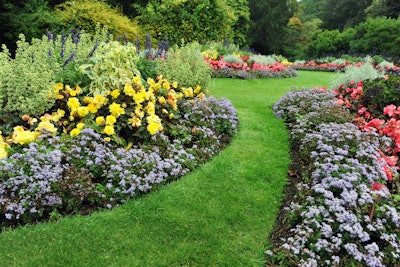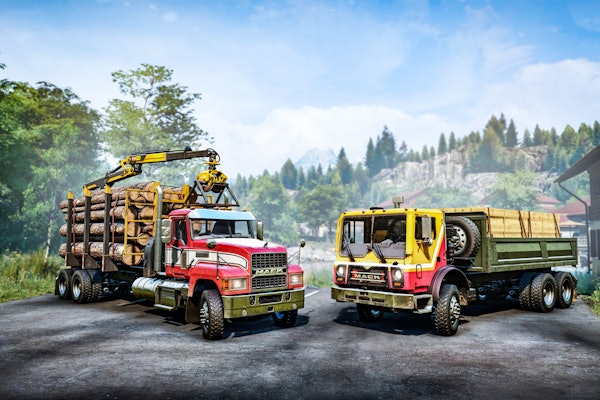
Even if you’ve taken the time to carefully select a variety of beautiful flowers for your customer’s garden, having a bed that looks very blasé will take away a good portion of the appeal, so take a look at a few ideas you can implement to bring the pizzazz back to your customer’s garden.
Layout and shaping
When creating or re-creating a garden bed for your customer, The Garden Academy highly recommends keeping the principles of width, height, length and geometry in mind, as there are numerous shapes you and your customer can choose from.
“There are two stages of shaping,” The Garden Academy says online. “The first is the initial layout of the bed. The second is shaping the contour of the soil after filling with bed mix or completing soil prep.”
According to The Garden Academy, the layout is the footprint or outline of the bed before the turf is removed and the soil is prepared. When laying out a design concept, it’s recommended that you take time to walk the entirety of the area surrounding the bed to ensure you’re able to see every angle, including the street angle, as The Garden Academy says it’s important to know how pleasing it will look from every vantage point.
Plus, having an attractive garden bed in view of the surrounding streets could help boost your customer’s home value, which could come in handy if he/she ever reaches the point of wanting to sell the house.
Once the perimeter has been established, it’s then time to choose the shape of the bed.
Islands and borders
According to Kerry Meyer, contributing writer with Proven Winners, it’s important to view gardens as a personal work of art, which means that you do have to account for your customer’s personal taste when working on designs.
Meyer says that understanding the basics of design principles is important for two reasons.
“First, if you know the rules, you can break them in an intelligent way,” Meyers told Proven Winners. “Second, it helps give you a comfort level that what you design won’t be a complete disaster.”
Meyers says that there are two types of garden beds: island beds and borders. Because the borders are typically anchored by a backdrop, Meyers says these beds are easier to visualize than the island beds, as the backdrop will help define the new bed’s size. Backdrops can be houses, hedges, or other things that provide a solid background, and Meyers says that borders are only viewed from one side.
Typically speaking, flower borders tend to be long and narrow, and Meyers says the depth of the bed will depend on how long the bed is.
“The proportions of the bed are important,” Meyers told Proven Winners. “A short bed doesn’t need to be as deep; a 3-foot by 8-foot bed will look right at home. A longer bed will need more depth, if possible. A 12-foot by 100-foot bed will look proportional.”
When dealing with island beds, Meyers notes that they will not be anchored by a backdrop and can therefore be viewed from all sides. Typically, these beds will have a center anchor, but she says that anchor doesn’t necessarily have to be located in the center of the bed. To create an asymmetrical look, the anchor can be set off the one side.
Meyers says that anchors in the center of the bed can be anything from a tree, large perennial or shrub to statues, benches, large containers or an arbor. This is where you can talk with your customer about certain aspects he/she would like to incorporate into the landscape and use it as a point of reference when designing the space.
When creating island beds, Meyers says to remember that they are typically more round, square, rectangular or amorphous in shape, and very rarely will they be skinny and long.
“As with borders, their length and width need to be somewhat proportional, so longer beds need to also be wider,” Meyers told Proven Winners. “Island beds can be small, a mailbox planting for instance, but are more often large. Since island beds can be reached from all sides; only beds larger than 6 to 8 feet across will need access for maintenance.”
Contouring and plants
Contrary to what your customer might think, garden beds don’t have to be all one height, flat or one dimensional. The Garden Academy says that these spaces can even consist of high and low spots, swales and berms.
“Contouring can be done with the design in mind or to suit the needs of the plants, particularly as to drainage,” The Garden Academy says online. “It is done after the soil prep is complete but can be done before or after the border is installed.”
After contouring is complete, the Garden Academy recommends watering the bed thoroughly to allow the soil to settle. This should also give you time to address any areas of the bed that settle more that you expect before you start the process of mulching and planting.
Generally speaking, Meyers says plants in these borders will need to be arranged tallest in the back, mid-size in the center and the shortest plants closest to the bed’s front.
“It is best to use groupings or drifts of plants for a natural feel,” Meyers told Proven Winners. “The other thing to consider when planning your plant placement is that it is often best to use groupings of at least three of the same plant together. One plant alone often does not have enough impact, where a grouping of three, five, seven or more will have good impact. Odd numbers tend to look better than even numbers. This is especially true of smaller plants where groups are necessary to have impact.”
Meyers adds that shorter plants can also be used in beds that are long and narrow to create a border around the edge of the bed. Meyers does warn that there can be an exception to the three or more plants rule when dealing with large perennials and shrubs, as these will be able to comfortably and confidently stand alone without needing to be grouped.
When planting in an island bed, Meyers says there are similar principles to keep in mind, but instead of having taller plants in the back, they will be better placed in the center of the bed or could also act as the bed’s anchor.
“Your design doesn’t need to be rigid,” Meyers told Proven Winners. “Some medium sized plants (can) come to the edge of the bed and some short plants (can be) right next to tall plants. The tall to short progression is simply a rule of thumb, not a hard and fast rule.”











